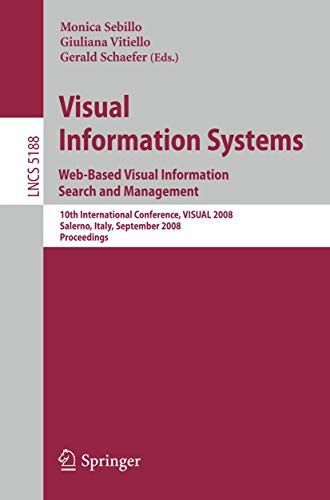
Visual Information Systems. Web-Based Visual Information Search and Management 10th International Conference, VISUAL 2008, Salerno, Italy, September 11-12, 2008, Proceedings
The international conference series on Visual Information Systems (VISUAL) originatesfromtheideathattheexchangeofviews, resultsandexperienceswould allowresearchersandpractitionersworkingin the areaofvisualinformations- tems to address commonproblems moree?ectively. Following the success of p- vious editions held in Melbourne (1996), San Diego (1997), Amsterdam (1999), Lyon (2000), Taiwan (2002), Miami (2003), San Francisco (2004), Amsterdam (2005), and Shanghai (2007), the aim of the 2008 edition of the International ConferenceonVisualInformationSystemswasto providea fruitful forumofd- cussioninresearch?eldsrelatedtocomputervision, databases, humancomputer interaction, image processing, information visualization, and knowledge and - formation management. The University of Salerno was honored to celebrate the 10th edition of VISUAL, choosing a prestigioushotel situated on the enchanting Gulf of Salerno, located between the beautiful Coast of Amal? and the Cilento National Park (both part of UNESCO patrimony). VISUAL 2008 received 58 submissions, which were reviewed by more than 38 international experts in the related research ?elds from 19 di?erent countries. The resulting technical p- gramcontinuedthetraditionofmixingcarefully-reviewedresearchcontributions, experience reports and other activities with plenary presentations. Papers c- lectedinthis volumeinclude, butarenotlimitedto, topics ondatavisualization, geovisualization, image and video databases, mobile visual information systems, visual data mining, machine learning and pattern recognition techniques for - sualinformationmanagement, andapplicationsofvisualinformationsystems. In particular, three keynote talks were delivered at VISUAL 2008 and six thematic sessions were organized. The ?rst invited talk, A Visual Analytics Approach to Exploration of Large Amounts of Movement Data, was given by Prof. Gennady AndrienkoincooperationwithNataliaAndrienko, fromthe FraunhoferInstitute Intelligent Analysis and Information Systems. Prof. Andrienko faced the issue of enhancing human interpretation of movement data and described the results of their research experience about adequate analysis methods.